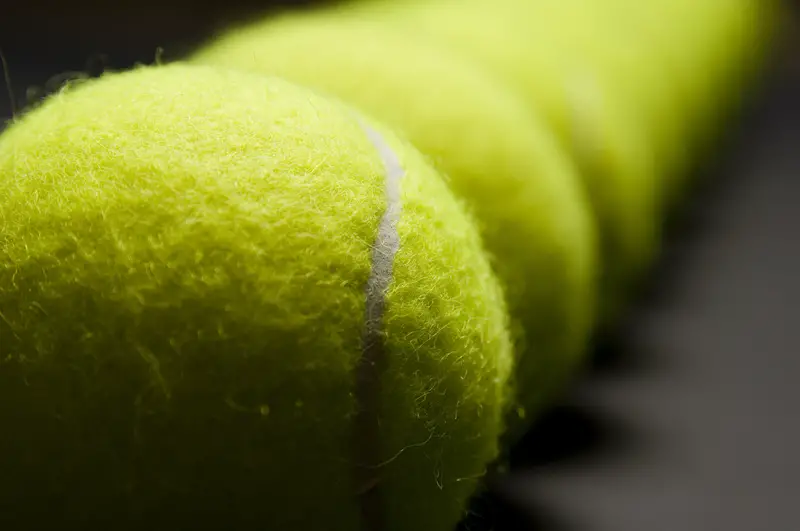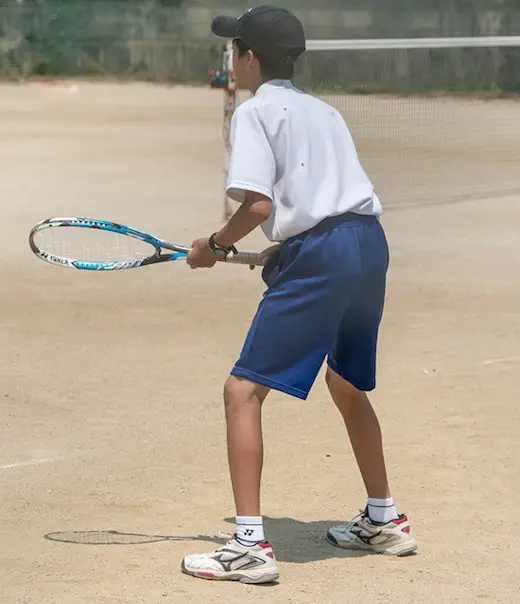- The very first tennis ball – wood (dating back to the 1300s)
- First mass-produced tennis ball – rubber
- Today – rubber and felt
Your Guide
 Gavin Davison
Gavin Davison
This is actually a very interesting topic. The more you research, THE MORE YOU’LL REALIZE that opinions and facts vary greatly.
However, historians believe that the original tennis ball dates back to the 1300s.

With this being 700 years ago, sadly, NO LIVING HUMAN CAN CONFIRM – none that I’m aware of anyway!
On that note, it is widely accepted that French Aristocrats started to play some form of tennis during that century.
And wooden tennis balls have been recovered by historians IN RECENT TIMES.
So if you want to be super technical, these wooden balls were the first documented tennis balls.
But in the interest of talking about tennis balls since the sport has been played BY THE MASSES, the first tennis ball would then be viewed as rubber.
I did say it was an interesting topic!
This was all made possible since a rather CREATIVE MAN by the name of Charles Goodyear developed the process of vulcanizing rubber.
That occurred around the 1840s, and some enterprising Germans started TO SELL PRESSURIZED, rubber balls.
But by the 1880s, opportunistic businessmen were developing tennis balls with rubber and felt.
Clearly, tennis balls have gone through QUITE A CHANGE over the years.
Let’s look into this fascinating piece of history in greater detail now, shall we?
Details of how the first tennis ball came to be
Ignoring the historian’s estimate of wooden balls by the 1300s, LET’S FOCUS on the creation of the rubber tennis ball.
There simply ISN’T ENOUGH EVIDENCE or documentation to talk too much about the wooden balls used by the French Aristocrats, and I’d hate to be TOO SPECULATIVE with the information provided!
Instead, let’s take a look at the specifics for the rubber tennis ball.
Charles Goodyear Vulcanization Process
Do you know of an enterprise named the Goodyear Tire and Rubber Company?
You probably do – they are one of the MOST SUCCESSFUL rubber-tire-producing enterprises of the last few Centuries.
This all stemmed from Charles Goodyear’s discovery of how to vulcanize rubber, an experiment that he performed in the 1840s.
He was actually a chemist who happened to stumble across this process during a series of INTERESTING EXPERIMENTS.
Basically, vulcanization hardens rubber and makes it more responsive to the environment.
It also makes the rubber more:
- Resistant
- Strong, and
- Flexible.
My interpretation is that vulcanization effectively takes regular rubber and turns it into a better version.
We don’t need to get much MORE SCIENTIFIC than this for the purposes of this short read.
And sure, this experiment wasn’t performed with the intention of making tennis balls.
But it did PAVE THE WAY for the process to be used for manufacturing balls and transforming the game of tennis as we know it.
Pressurized Rubber Balls From Germany
News of Goodyear’s process OBVIOUSLY REACHED Germany a few years later, and that’s where the first tennis ball starts to become well-documented.
These rubber balls were manufactured from the late 1840s onwards, and according to reports, they were either Red or Grey with NO COVERING.
The balls were also lightly pressurized to give them BETTER RESPONSES from the court, much to the delight of tennis players of that era.
However, the development of the tennis ball obviously sent shockwaves through the tennis world.
Everyone wanted to get in ON THE ACTION, and another enterprising individual by the name of Walter Wingfield visualized the next transition.
He was a Welsh inventor, and it was Wingfield who came up WITH THE IDEA of adding flannel to the balls.
Of course, this didn’t STAY SECRET FOR LONG, and by the 1880s, tennis balls were being sold with a felt covering.
Pressurized Rubber With the Addition of Felt/Cloth
Tennis balls were actually BEING SOLD with this recent change in England during the 1880s.
This was the case for many decades, with VERY FEW CHANGES to the design of a tennis ball up until the 1920s.
This was the decade in which the modern-day tennis ball started to really present itself. Previously, tennis balls were just ‘Lightly Pressurized’ to give them a bit of ADDED BOUNCE from the court surface.
However, the 1920s then implemented balls that were pressurized to a significantly GREATER DEGREE.
Of course, these pressurized tennis balls were also made with cloth/felt around the outside of the ball.
This cushioned the ball regarding how IT REACTED TO THE SURFACE the strings at the time, and it really did revolutionize the way that tennis was played.
The modern-day tennis ball
It’s fair to say that the tennis ball has come A LONG WAY since the 1800s.
With that said, the ball has come an even longer way if we turn our attention back to the 1300s.
I’m CERTAINLY PLEASED that we don’t play with wooden or rubber balls these days, mind you!
On that note, modern-day balls use the same:
- Vulcanized Rubber,
- Felt/Cloth, and
- Pressurization Process
that came about back in the 1920s. For those that are interested, here’s how tennis balls are actually MADE TODAY:
As you can see from the video, two rubber cups are now STUCK TOGETHER to create the round ball we use today.
The process is incredibly slick too, and tennis balls are now produced in a way that allows one ball to be IDENTICAL TO THE NEXT.
Fun fact for you - there are now 200+ tennis ball variations manufactured these days.
That’s certainly a whole lot more than the singular variation produced back in the 1800s.
Tennis balls are EVEN ALTERED in terms of the:
- Thickness of Felt
- Pressure, and
- Ultimately – Cost
That’s because tennis has evolved to now be played on multiple surfaces, which has naturally demanded MORE VERSATILE tennis balls for the most optimal playing experience.
Did you enjoy this quick read on the original tennis balls?
Do you have any other interesting historical facts to add? I’d love to hear them in the comments if so!


